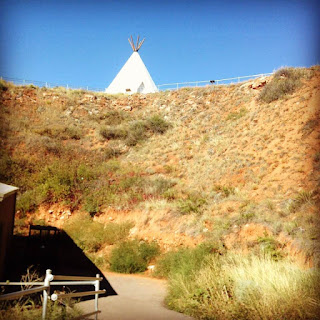There was a time when the grasslands of the Great Plains were thick with buffalo, an important resource to the nomadic Native American tribes for centuries. When you think about Indians hunting buffalo this is the image that comes to mind, right?
 |
| Indians Hunting Buffalo, by Charles Marion Russell |
A mounted rider, skillfully chasing down a single beast and taking aim with bow and arrow. And that happened...but not until sometime after the introduction of the horse by Spaniards in the 16th c.
And it wasn't until the mid 18th c that the horse became fully part of Great Plains Indian culture, changing their lifestyle.
And yet, before that time there was this...
 |
| Pack Dog Pulling Travois |
And this...
 |
| Driving the Herd Over a Cliff |
In the 1970's during construction of Interstate 90, engineers encountered a problem in the form of a hole. A big hole that would need filling before roadwork could begin. Fortunately, a few exploratory digs revealed that the hole was filled with bones, and archaeologists from the University of Wyoming were called in. A significant find was discovered and Interstate 90 was slightly rerouted.
Somewhere between the Black Hills of South Dakota and the Devils Tower in Wyoming is The Vore Buffalo Jump, one of many such natural kill sites in north central America and Canada.
The Vore Buffalo Jump, named after the Vore family ranch it sits on, is a sink hole 40 feet deep and 200 feet in diameter.
It was used as a kill and butchering site from about 1500 AD to 1800 AD by the Kiowa, Apache, Shoshone, Hidatsa, Crow, and Cheyenne tribes, who every fall harvested the buffalo for their meat and hides in preparation for winter. The sinkhole contains the bones of approximately 20,000 buffalo who plunged to their death.
 |
| Excavation at Vore Buffalo Jump (author's photo) |
How do you convince a herd of buffalo to leap headlong off a cliff? One way is to deck out your fastest runner in a buffalo robe and headdress. Then while others harass the animals into running, the decoy "buffalo" positioned between the cliff edge and the herd, lures them in his direction. Then the decoy jumps out of the way (hopefully) into a safe cranny while the buffaloes in the rear push the buffaloes in the front of the herd over the cliff.
But it wasn't only buffalo bones that have been found (the site is only 5% excavated, by the way) but projectile points, stone tools, and five canid skulls. And because the silt washes down periodically it covers and preserves the aftermath of each separate event like a snapshot of the mayhem that took place on a day so long ago.
I was fortunate enough to visit the Vore Buffalo Jump in our trip west in 2017. It was supposed to be closed for cleaning but they let us in for an informal tour. Among other things of interest, the five canid skulls, or wolf-dogs caught my attention because they tell of a time before horse-culture took over the Plains.
 |
| Looking down into the sinkhole. The roofed structure covers active archaeological work. (Author's photo) |
The wolf-dogs weren't used in the buffalo hunt itself as their tendency to chase would interfere with an organized herding effort. They would have been tethered back at camp. So how did the wolf-dogs skulls end up in the pit? It's likely that after the Indians had butchered and taken their gains back for a communal celebration, they let the dogs have a free-for-all amid the scraps. The dogs found in the pit may have been killed competing with other predators, where without their canine teeth, they wouldn't be able to defend themselves properly.
 |
| Standing at the bottom, looking up. The tepee-like building on rim is the Interpretative Center (Author's photo) |
 |
| If you made it this far, you're almost there! Vore Buffalo Jump. |
For more information on the Vore Buffalo Jump:
https://www.vorebuffalojump.org/content/
Images not the author's own are courtesy Wiki Commons
Fans of historical western tales, don't miss this collection of six full-length novels from Prairie Rose Publications. Still only $0.99
https://www.vorebuffalojump.org/content/
Images not the author's own are courtesy Wiki Commons
Fans of historical western tales, don't miss this collection of six full-length novels from Prairie Rose Publications. Still only $0.99


6 comments:
Oh, I'd love to see this--and weren't you lucky to be permitted in on a day it was closed?! I knew about buffalo jumps but didn't know one was excavated--would love to see this. Thanks for sharing about your visit.
It looks like they plan to expand the site and interpretive center based on their website. I hope you get to see it on one of your trips to WY. Thanks for stopping by!
I never knew about this. It must have been a very gruesome place.
It really is hard to imagine...and I don't really want to! You know I studied archaeology in school and find this stuff fascinating, but one thing to look at bones and another to witness an event like a hunt. I can't even watch stuff like that on TV. On this same trip we saw the Mammoth Site in Hot Springs, SD, which is a similar site, except they're excavating bones of animals who wandered into the sinkhole on their own. Thanks for stopping by, Kristy!
I was not aware of this site. How very fascinating. To me the creative way our ancestors made their way in the world is so worth studying. Doris
Doris, is amazing how we have adapted and survived! Thanks for stopping by.
Post a Comment